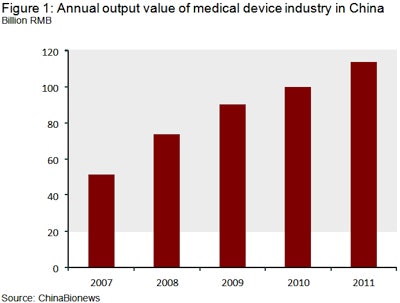
As China rushes to modernize its healthcare system, big cities such as Beijing and Shanghai have attracted most of the attention. But medical imaging vendors are now moving into China's vast countryside. Owen Tang of ChinaBionews offers a look at China's new frontier for growth.
The Chinese medical device industry has been growing strong since China began a healthcare reform plan in 2009, recording an average growth rate of 25%, according to China's Ministry of Science and Technology (MOST) in its five-year plan of the medical device industry. MOST has also forecasted that the total output value of the medical device industry will reach RMB 200 billion ($32 billion U.S.) by 2015.
Providing basic health services to rural people has been one of the main targets of the reform plan, with county hospitals and town-based health centers as the two key health institutions for providing basic services for much of the population. China's government had already planned to support 2,000 county hospitals with investments and policies in 2009.
In 2012, many multinational medical imaging companies accelerated their plan to expand their rural healthcare activities in China. After first penetrating the middle- and high-end market segments, these multinational players see rural China as the next great opportunity.
 |
The following describes the activities of several of the largest medical imaging vendors in China's rural healthcare market.
GE Healthcare
In early 2011, GE Healthcare initiated its Spring Breeze Plan with the aim of supporting and expanding rural healthcare over the next three years by addressing China's 7,000 county hospitals and 50,000 health centers.
The company has launched a series of In-China-for-China (ICFC) products, including the Logiq C series of ultrasound scanners, Starlight analog x-ray products, and Brivo CT systems. GE Healthcare will launch more than 40 products in the next three years, 70% of which will be designed specifically for rural healthcare, according to Duan Xiaoying, CEO of GE Healthcare China. It is also expected that more than 50% of revenue will be generated from rural healthcare in the next five years.
Brivo CT is designed specifically for county hospitals, and with a competitive price point and easy-to-operate features, it has been widely accepted. Meanwhile, Brivo XR 515/575 is the first flat-panel digital x-ray system for rural healthcare.
In April 2012, GE opened its fourth innovation center in Chengdu, following centers in Beijing, Shanghai, and Wuxi. The center involved an $80 million investment and will mostly cover China's southwest region, developing products mainly for users in China's tier 2 and tier 3 cities and rural areas.
Also in 2012, GE founded a financing and loan division, with the aim of providing financing support to county hospitals that lack the money to purchase medical devices. It also plans to offer funding support to health centers in the next few years.
Financing support is what most county hospitals currently really need, as funding from China's government is still not enough, and most county hospitals in rural areas are lacking money, medical equipment, and experienced physicians.
Philips Healthcare
In October 2012, Philips Healthcare officially initiated its Dandelion Plan, which could be regarded as its entry into the rural healthcare market in China. The plan will cover product design, financing, after-sale service, training, and information platforms.
 Owen Tang.
Owen Tang.
Many years ago, Philips set up a rural healthcare department internally, which integrated its local resources with R&D, sales, manufacturing, and team building, but it was not disclosed publicly until 2012.
In 2009, Philips invested $54 million in its Suzhou manufacturing facility, which will support its rural healthcare business in the Asia-Pacific region. The facility went into operation in 2012 and will manufacture products for the Chinese rural healthcare market with competitive prices.
Meanwhile, Philips will soon open a facility to provide resources for training physicians from rural healthcare institutions. From 2012 to 2016, a new product will be provided to the rural healthcare market twice a month, according to Desmond Thio, president of Philips Healthcare Greater China.
Finally, this month Philips and Neusoft Medical Systems announced they are breaking up their joint venture business in China to go their separate ways. Intellectual property rights from the joint venture will be shared by both companies. In addition, a team of approximately 100 to 150 CT system and component engineers and supporting staff will transfer from the joint venture to Philips.
Siemens Healthcare
In 2006, Siemens Healthcare introduced its SMART strategy to deliver products and solutions that are "simple, maintenance friendly, affordable, reliable, and timely to market," and that are dedicated to the needs of emerging markets. Particularly since the introduction of the 12th Five-Year Plan, Siemens has given priority to expanding to lower-tier markets.
In the near future, Siemens will present more products for rural healthcare, including CT for county hospitals. Siemens will also focus on developing entry-level medical equipment, and it will promote local-for-local solutions to empower local channels, enhance regional management, and better understand and satisfy customers' needs.
Other players
Besides GE, Philips, and Siemens, other multinational players such as Carestream Health and Toshiba Medical Systems have been active in the expanding rural healthcare business.
Carestream initiated a rural healthcare IT pilot project in Ningxia province in 2007 with investment of RMB 10 million ($1.6 million U.S.). Covering six county-level hospitals, seven township health centers, and four village clinics, the project had provided more than 500,000 digital medical imaging services to 1.5 million local people by September 2011.
It was reported that GE and Siemens had conducted similar projects in Chengde of Hebei province and Luochuan of Shaanxi province, respectively, but none was as successful as Carestream's project.
Developed by its Shanghai R&D center, Carestream's DRX-Nova digital radiography (DR) system could meet the needs of most middle-scale hospitals in China, at a competitive price point. Carestream also leads the Chinese computed radiography (CR) market with around a 40% market share.
In March 2012, Toshiba opened its fourth training center for scientific research in Beijing, following centers in Japan, the U.S., and Europe. With medical equipment including 3-tesla MRI scanners and the Aquilion One CT scanner, the center is able to provide training courses to more than 280 people. In October 2012, Toshiba opened an R&D center in Beijing to develop products specifically for the Chinese market.
Creating opportunities
China's effort since 2009 to improve its focus on rural healthcare creates major opportunities for both local and multinational medical imaging suppliers. It has been reported that 30% of county hospitals were lacking enough medical equipment, while in rural areas the percentage reaches 50%.
Medical imaging equipment is widely used by Chinese hospitals. With government support and solutions from suppliers, county hospitals and even health centers can purchase more advanced medical imaging equipment such as CT, DR, and color ultrasound.
Multinational companies are setting their sights on the entry-level segment after winning success in high-end market segments, while most of China's local imaging manufacturers are upgrading their products to compete with multinational players. They will compete in the county hospital segment first, but will eventually expand to cover the whole rural healthcare market, with more mergers and acquisitions expected in 2013.
The years ahead offer challenges to all players, as there are many rural healthcare institutions covering wide areas, and their demands and purchasing power will be completely different. Multinational medical imaging suppliers have presented a series of localized solutions to expand their China business, including specially designed products, local R&D teams, financing services, and local sales channels. GE's In-China-for-China slogan could stand for all their ambitions in the Chinese rural healthcare market.
About ChinaBionews
ChinaBionews is the professional information and marketing solutions provider for the Chinese medical technology industry. With its two websites, one in English and one in Chinese, ChinaBionews provides Web-based services, publications, and consulting services to clients. For questions, please contact Owen Tang, founder of ChinaBionews, at [email protected].
The comments and observations expressed herein do not necessarily reflect the opinions of AuntMinnie.com, nor should they be construed as an endorsement or admonishment of any particular vendor, analyst, industry consultant, or consulting group.




















